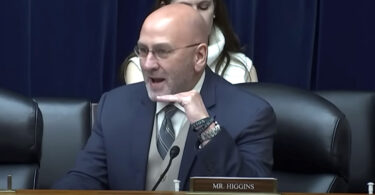“Is our government leading us toward happiness as a people? I think the answer is clearly no. In fact, the more that the radical Left gains power within the bureaucracy and pushes its ideologies on the people, the less happy the people become.”
By Christopher Rufo
The Synthetic Revolution: How the old Marxism evolved into a new orthodoxy
. . . . . Which leads us to the final question: How do we create an opposition? What are the means of opposing the forces of ideological capture and the politics of “diversity, equity, and inclusion”?
We find ourselves, institutionally, with very little at our disposal. So what do we do?
To answer this question, we must acknowledge the status quo. I use the label “conservative” because it’s convenient to signal where my political loyalties lie. I’m part of the conservative movement—those are my friends, colleagues, collaborators. I have a relationship with the conservative political party, but “conservative” is, in a sense, not a functional label for what we have to do.
The project of conserving the institutions and the transmission of the founding principles of our country has already failed.
Conservatives who adopt the posture of the establishment are deluding themselves because, in reality, we are now on the outside, the fringes, the margins.
Our ideas—the ideas of the founding of this country—are no longer the public orthodoxy. Consequently, it’s not a matter of conserving the institutions as they are; it’s a matter of going on offense and changing the institutions into what they might be.
First, we must re-establish the political.
I often hear people say, “I don’t want to make this political. I don’t want to be controversial. I want to avoid conflict.” These people are not well-equipped for politics, because politics is political.
If you criticize the public orthodoxy of the day, you’ll be automatically labeled as someone who is controversial. You have to accept this. Then you can begin to submit these institutional questions to the political process.
You can begin to ask, why are conservative taxpayers paying for DEI bureaucracies and public universities? Why are they paying for departments of gender theory, which, as an intellectual matter, are equivalent to a department of witchcraft or astrology?
This is precisely the project that I have worked on this year: persuading state legislators that they did not have to fund radical, left-wing DEI bureaucracies in state universities.
The people, through their legislators, are the ultimate authority over the structure and values of public institutions, and if they decide that they do not want to promote DEI as the official orthodoxy of state institutions, they can lobby their legislators, who can write a bill to abolish those departments and send it to the governor’s desk for signature.
And that’s exactly what happened in the State of Florida. These DEI bureaucracies, which offer no academic value, are no longer permitted in the state’s public universities.
Second, we should appeal to and enact a sense of pluralism.
This is where small “c” conservatives can play that conservative function, which is to say that the existing institutions of civil society—the family, the church, the school, the civil association—should be protected.
This means digging trenches around those institutions, creating space where those institutions can survive. The sociologist Max Weber talked about “value spheres.”
This is a productive way to consider our local institutions that haven’t been captured by these ideologies: the neighborhood, the small town, all those little institutions that operate at a human scale, of which there are still many.
Conservatives must invest their time, money, and energy into these institutions and declare, “This is important. This is what we believe. This is where we will stand and protect these values, within the sphere of activity in civil society.”
The third tactic is an institutional siege.
If you think about the primary shapers of national life—the federal government, the Fortune 500 companies, the large K-12 school systems, the universities—they are all institutions that must be submitted to public deliberation, to a political process, and to a contestation of values.
In a constitutional republic, this means submitting them to basic rules, which are determined through the Constitution and the legislature, the ultimate authorities over the great public questions.
We must ask: Where are our institutions headed? What do our institutions believe? Which values do our institutions transmit from one generation to the next?
These are the fights we must have. The greatest leverage for conservatives is political power—more specifically, the political power of the legislatures, which must ensure that the values of their constituents, of their citizens, are reflected in the public institutions.
This is, in one sense, simple, and in another sense, very difficult. Because it requires people who are willing to fight both in media, politics, and other domains.
And it requires, ultimately, replacing one system of values with another. It is tough work.
We must be willing to say, “We have an institution and now we’re going to bring in new people, new values, new policies, and new priorities.”
The challenge is great—we must begin this process across a wide range of institutions—but, if we understand our opponent and have an abiding faith that our republic is still functional, we can win elections, translate values into law, and reform the institutions so that they are governed in the best interest of the people.
This is the work of a generation or more.
This problem developed and metastasized over the course of many decades. It will take many decades to fix it, but ultimately, this is the fight we must face.
If we have political convictions, it is not hopeless, but rather, salutary, to understand just how difficult the task is ahead, because it gives us a sense of realism and perspective.
Many generations before us have waged more difficult fights than ours. For the time being, ours is a fight over language, words, symbols, bureaucracy. We should maintain hope—this is the fight ahead.
. . . The radical Left has moved from an organic constellation of intellectuals, activists, and other figures to a synthetic constellation of political actors—meaning, these ideas are now part of our bureaucratic life. They are incentivized bureaucratically and administratively, rather than bubbling up from below. We have “synthetic revolutionaries” who are highly credentialed. They march up the cursus honorum, or the scale of credentialing, in our society. They adopt these ideologies, not as authentic commitments, but, in many cases, as very cynical trappings: “This is what I’m supposed to believe and, therefore, I will say the words.” We see this almost everywhere, and, for many people, it’s a matter of institutional survival. They affirm the orthodoxy because they don’t want to get fired. . . .
How to Fight a Tyrannical Movement
By James Lindsay, New Discourses
How can we fight a tyrannical movement trying to take over our society or mislead people into traps? One key thing to do is to understand how people relate to such movements and organize our messaging and activity in a way that targets them for where they are.
Adopting a model from a recent talk, in this episode of New Discourses Bullets, host James Lindsay discusses five primary (and a few secondary) dispositions with regard to tyrannical movements and how to target messaging and activity toward each of them.
This should help people fighting the movement be more aware and effective in their efforts, which can be more targeted across a wide set of necessary aims. Join him to learn how to fight a tyrannical movement.
How to Organize to Beat the Left
By James Lindsay, New Discourses
It’s time to start winning. That requires knowing our enemy, which we’re doing pretty well with, getting organized, and enacting a strategy to consolidate power for the Cause of Liberty to save our schools, towns, states, and nations.
The strategy is actually pretty simple, though, and it’s organizing to create a positive feedback loop between recruiting numbers, identifying and achieving specific objectives, and building and channeling momentum (including into fundraising).
This is less hard than it sounds, even in deeply embattled areas. The strategy is simple: get some numbers and recruit around the idea of getting enough numbers to take over some small local thing, to get it under your control.
Make sure it’s an achievable goal, then drive to achieve it. When you achieve it, turn the victory into momentum to go after the next target.
Recruit on the success and to the need of achieving the next goals. Then just keep repeating!
In this episode of New Discourses Bullets, host James Lindsay breaks down this community organizing 101 for conservatives. Join him and get back on the field to start taking back ground!








Leave a Comment